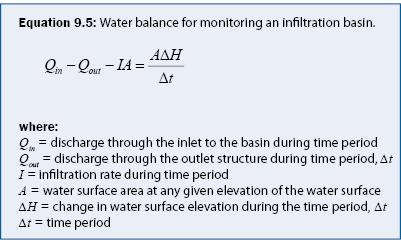
Monitoring Infiltration Practices
J.L. Nieber, A.J. Erickson, P.T. Weiss, J.S. Gulliver, R.M. Hozalski
Some infiltration practices may be too large for synthetic runoff testing (i.e., a sufficient water supply is not available) and therefore may require monitoring (level 4) to achieve the assessment goals. To successfully monitor a stormwater treatment practice, it is necessary to follow appropriate procedures for Water Budget Measurement, Sampling Methods, and Analysis of Water and Soils. In addition, there are some monitoring considerations specific to infiltration basins, trenches, and permeable pavements provided in the following sections.
Infiltration basins
To measure flow into the infiltration basin, a weir, flume, or area-velocity meter can be placed at the inlet location as described in Water Budget Measurement. If the inflow is through a pipe directly into the basin, the flow-area meter is the best choice of flow measurement device. If the inflow is via an open channel, the flow can be measured with a weir, a flume, or an alternative depth-discharge relationship for the channel.
At the outlet of the basin, if there is one, the flow is typically controlled by a drop inlet structure. The hydraulics of that structure can be determined from weir and orifice formulae based on the geometry of the outlet. When the hydraulics are known, outflow through the structure can be estimated by measuring the elevation of the water in the basin. Measurements of the water level should continue as the water level drops below the outlet. The infiltration rate can then be determined using a water balance for the basin as represented by equation 9.5.

If the basin is underlain by a drain pipe, it is necessary to measure the discharge from the drain pipe as well. The magnitude of the expected discharge from the drain pipe, which is dependent on the size of the structure, will determine the type of flow measurement device. For small flows, a tipping bucket device will work well, while for larger flows, a weir, flume, or area-velocity meter may be necessary.
Infiltration trenches
Infiltration trenches function by storing water on the surface of the trench and then permitting the water to infiltrate through that surface. If the inflow into and outflow from the submerged area can be measured, the flow capacity of a trench can be estimated by monitoring. If both the inflow and outflow points are well-defined, the flow can be measured with a weir, flume, area-velocity meter, or a suitable stage-discharge relation. The water level in the submerged area also needs to be measured over time.
Assuming that the inflows, outflows, and submerged surface elevation can be measured, the discharge into the trench can be determined from a water balance given in equation 9.5. Applying this water balance assumes that the infiltration into the soil surrounding the trench is negligible. Infiltration trenches are used in areas where the surface soil has very small infiltration capacity and therefore this assumption is generally valid.
Permeable pavements
The infiltration performance of permeable pavements can be assessed by monitoring incident rainfall with a rain gage and runoff at an appropriate outlet point for the pavement. For permeable pavement parking lots, the edges of the parking lot will usually be bounded by curbs or other berm-like conditions. The discharge (runoff) from the pavement can be measured at the pavement overflow location. The rainfall depth minus the depth of runoff from the pavement will be equal to the infiltrated water.
Continue to Maintenance.